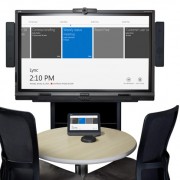Video is the new voice.
From telepresence systems to smartphone apps, video communication has become as ubiquitous as the humble voice call, writes Deirdre Cashion.
The increased proliferation of mobile devices has caused a disruptive shift in how we consume technology. And like most areas of business and life, the video conferencing landscape has not been left untouched by this unrelenting tidal wave of technological change.
With increasing interest in ‘Bring your own Device’ (BYOD) coupled with developments in smartphone apps, video communications now extends well beyond the boundaries of the stuffy boardroom, onto the desktop and right into our pockets.
Consumers have been using apps such as Skype to conduct face-to-face conversations for some time now but how do these visual technologies apply in the business world and how are video conferencing vendors adapting their service offerings to cater for this new phenomenon?
According to leading analysts Gartner, the market for telepresence and video conferencing systems is maturing but this is matched by a corresponding shift towards personal video, with ‘soft’ clients for desktop and mobile users growing in popularity.
“A lot of larger companies in Ireland are still using expensive legacy systems in boardroom settings,” according to Alan Brown, business director with O2 Ireland. “But with the increased penetration of smartphones and high speed broadband, more affordable video-conferencing options are becoming commonplace in small businesses.
“Video conferencing has its place in all vertical segments but is most prevalent in businesses, which are located across multiple locations or have a team of mobile workers,” he said.
Niall Dunne, territory manager for Ireland with Polycom agrees and sees the growing popularity of video conferencing at home, especially by millennials entering the workforce, as a big driver.
“Video conferencing is only going to increase in popularity as organisations look to reap the benefits of remote and flexible working. Employees are increasingly geographically dispersed, either across countries or entire continents and video conferencing will allow more effective collaboration and more efficient meetings,” he said.
Adam Grennan, country manager with Cisco sees strong growth in the video conferencing market fuelled by a need to drive down costs and increase productivity. He sees a broad mix of customers ranging from large multinationals to indigenous organisations.
“Some of our multinational customers are putting directives in places where video should be used where possible instead of travel and in some cases instead of phone calls,” he explained.
“We are also seeing a wider adoption of video in some government departments; typically in departments or agencies that need to work together regularly. Video is becoming more pervasive and mainstream; you could say that video is the new voice.”
But video conferencing is no longer seen as the preserve of the multinational company or large enterprise according to Sean Holohan, managing director with Polycom distributor, Videnda.
While budget is important, he sees strong demand for rooms equipped with single or dual HD displays with a high definition codec, ceiling microphones and the ability to share content.
“The Polycom group system entry point for a single HD system is now cost-effective for a small-medium sized business so they might deploy one of those together with a number of desktop users. Desktop systems could start at €100 while group systems range from €3,000 – €5,000,” he said.
And as the financial director agonises over which IT project to fund with scarce financial resources, all commentators are unanimous in their assessment: video conferencing is one of the few technology areas where return on investment (RoI) can be very quickly demonstrated.
“It’s not just the cost of travel, it’s the cost of time,” according to Holohan. “When you look at RoI, there is a capital cost but it’s that ability to use technology to work smarter and not just internally but externally too,” he said.
“The only constant with video is that it is and will be constantly changing,” said Grennan. “The days of video systems being stand-alone, communication islands are long gone. Customers now want to know how their video conferencing units will integrate with their telephony systems and other IT services. Customer want to know how video will help them collaborate better with their customers, their colleagues and their partners. The case for implementing video is becoming a ‘no-brainer’,” he said.








Leave a Reply
Want to join the discussion?Feel free to contribute!